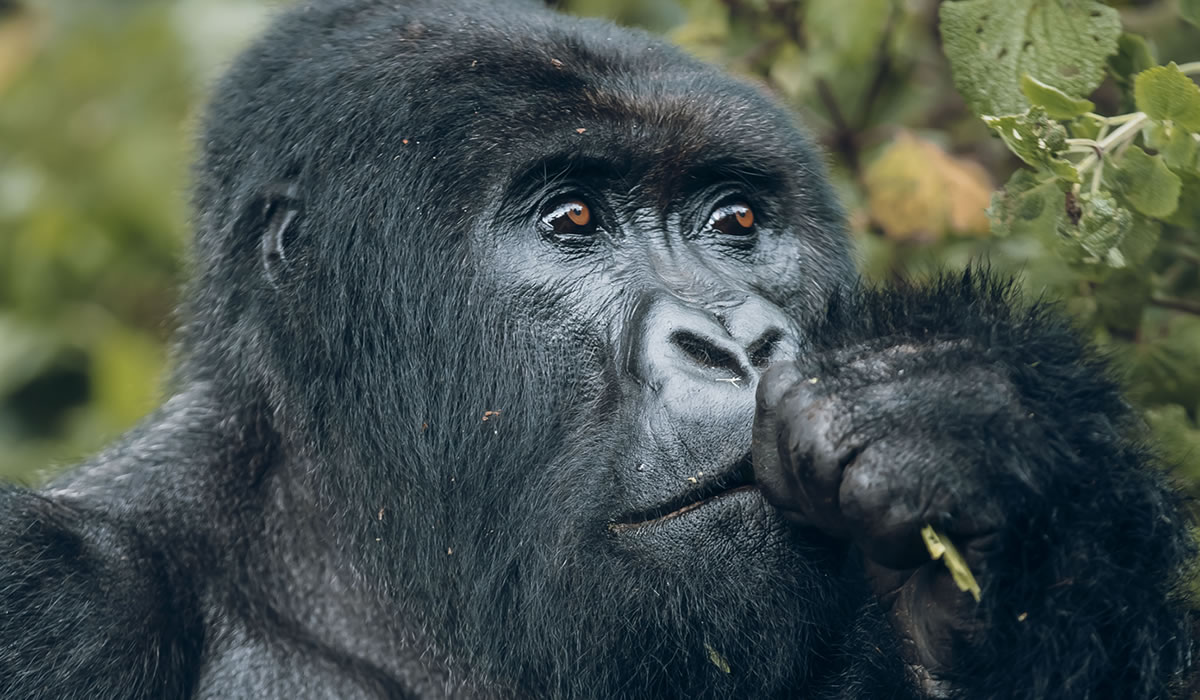Volcanoes National Park, located in the northwest of Rwanda, is one of the most iconic and biologically significant parks in Africa. Known for its lush landscapes, dramatic volcanic peaks, and abundant wildlife, the park attracts tourists from all over the world, particularly those interested in tracking the world-famous mountain gorillas that inhabit its dense forests. Spanning over 160 square kilometers, Volcanoes National Park forms part of the larger Virunga Massif, a volcanic mountain range that extends across the borders of Rwanda, Uganda, and the Democratic Republic of Congo. As Rwanda’s first national park, established in 1925, Volcanoes National Park holds historical importance in the country’s conservation efforts and continues to be a key symbol of Rwanda’s commitment to wildlife preservation, particularly its efforts to protect the endangered mountain gorillas.

The park’s landscape is dominated by five majestic volcanic mountains: Karisimbi, Bisoke, Muhabura, Sabyinyo, and Gahinga. These towering peaks, which rise to over 4,000 meters, create a stunning backdrop of steep slopes, deep valleys, and rich forests. The park’s diverse ecosystems, including montane forests, bamboo forests, and open grasslands, support a wide variety of plant and animal species, making it an ecological treasure trove. The area is rich in biodiversity, and its lush environment provides critical habitat for numerous species, including the rare golden monkeys, forest elephants, and a variety of bird species. The park’s varied elevations also allow for a range of unique plant life, including the iconic giant lobelias that dot the mountain slopes, creating a distinct landscape that sets Volcanoes National Park apart from other destinations in Africa.
However, it is the mountain gorillas that have made Volcanoes National Park internationally renowned. The park is home to more than half of the world’s remaining mountain gorillas, a species that was once on the brink of extinction. The success of gorilla conservation efforts in the park is a testament to Rwanda’s commitment to environmental preservation. Gorilla tracking, one of the most sought-after wildlife experiences on the planet, is the park’s biggest draw. Visitors from across the globe come to Volcanoes National Park to hike through the dense forests, following expert guides who lead them to one of the park’s habituated gorilla families. The experience of encountering these gentle giants in their natural habitat is truly unforgettable, offering a rare and intimate glimpse into the lives of one of the world’s most endangered species.
The park currently has a number of habituated gorilla groups, each with its own unique personality and family dynamics. Tracking these gorilla groups is a thrilling adventure that involves trekking through the forest, often at high altitudes, as visitors climb the slopes of the volcanoes. Once a group is located, visitors can spend an hour observing the gorillas as they interact, forage, and rest. The opportunity to watch these incredible creatures in their natural environment provides invaluable insights into their social structures and behaviors. Gorilla tracking is not only an incredible wildlife experience but also a crucial part of the ongoing conservation efforts. The revenue generated from tourism helps fund vital research, anti-poaching efforts, and community-based conservation projects, all of which play a significant role in preserving the gorilla population and the park’s fragile ecosystems.
In addition to mountain gorillas, Volcanoes National Park is home to several other species of primates, including the golden monkey, a small and colorful species that is also endangered. Golden monkeys are often spotted during hikes through the bamboo forests, and many visitors choose to track these monkeys alongside their gorilla trekking experience. The park is also home to a variety of other wildlife, including the elusive forest elephant, buffaloes, and various species of antelope. The birdlife in Volcanoes National Park is equally impressive, with over 200 species recorded in the park. Birdwatchers can spot species such as the Rwenzori turaco, the blue-headed coucal, and the white-headed wood-hoopoe, all of which add to the park’s ecological richness.
Beyond its wildlife, Volcanoes National Park is also a destination for outdoor enthusiasts and adventurers. The park offers a variety of activities, including hiking, mountain climbing, and cultural tours. For those interested in hiking, the park features several well-maintained trails that lead to the summits of the volcanoes. Climbing Mount Karisimbi, the highest peak in the park at 4,507 meters, is a challenging but rewarding experience that offers panoramic views of the surrounding landscape, including the Virunga mountains and the distant Lake Kivu. For those who prefer a more moderate trek, Mount Bisoke, which stands at 3,711 meters, offers an incredible hike to the summit, where visitors can view a beautiful crater lake nestled within the caldera.
Aside from hiking and climbing, the park offers a number of cultural experiences. The nearby communities, particularly the Batwa people, who are indigenous to the area, offer cultural tours that allow visitors to learn about their traditional way of life. The Batwa, also known as the “Pygmies,” have lived in the forest for centuries, relying on it for shelter, food, and medicine. Today, many Batwa communities are involved in eco-tourism, providing guided tours that offer insights into their culture, history, and the challenges they face in a rapidly changing world. These cultural experiences provide a deeper understanding of the region’s heritage and help support local communities through tourism.
The history of Volcanoes National Park is intertwined with the efforts to conserve the mountain gorillas. The park was originally established as a sanctuary for gorillas in the early 20th century, and it was here that renowned conservationist Dian Fossey conducted her groundbreaking research on gorilla behavior. Fossey’s work in the park is legendary, and her efforts to protect the gorillas from poaching and habitat destruction have left a lasting legacy. Fossey’s former research station, known as the Karisoke Research Center, is located in the park, and visitors can take a trek to visit her grave, which sits at the base of Mount Karisimbi. The center continues to be a hub for gorilla research, contributing to the ongoing conservation of the species.
Volcanoes National Park is also a focal point for Rwanda’s broader conservation efforts. The park is part of the larger Virunga Conservation Area, a transboundary conservation initiative involving Rwanda, Uganda, and the Democratic Republic of Congo. This collaborative effort aims to protect the region’s biodiversity and promote sustainable tourism, while also addressing the challenges of climate change and human-wildlife conflict. The park’s success in preserving the mountain gorillas and other endangered species demonstrates the effectiveness of conservation strategies when they involve local communities, tourism revenue, and international support.
Volcanoes National Park is a true gem of Rwanda, offering a unique blend of natural beauty, wildlife, and cultural significance. Its role in the conservation of the endangered mountain gorillas is legendary, and the park continues to serve as a model for wildlife protection and eco-tourism. Whether you are trekking to see the gorillas, hiking to the summit of a volcano, or exploring the rich cultural heritage of the area, Volcanoes National Park offers a wealth of experiences that make it a must-visit destination for nature lovers and adventure seekers alike. As Rwanda’s tourism industry continues to grow, Volcanoes National Park will undoubtedly remain at the forefront of the country’s eco-tourism initiatives, providing a sustainable model for conservation and community development.
